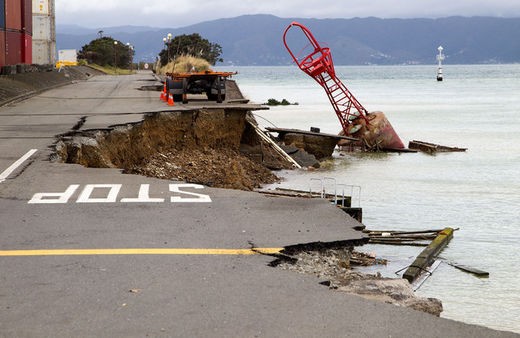
The earthquake struck at 5:09 p.m. local time and was centered offshore, 57 kilometers (35 miles) south-southwest of the capital city, at a depth of 14 kilometers, according to the U.S. Geological Survey. It was New Zealand's biggest quake since a magnitude 6.3 killed 185 people in the South Island city of Christchurch two years ago, and the strongest to hit the central region of the country since 1942, GNS Science seismologist John Ristau said.
There is an 8 percent chance of another magnitude 6 event or larger in the next 24 hours, and 20 percent over the next seven days, Ristau said in a telephone interview. "A large earthquake can increase stress or decrease stress on neighboring faults, that's what we're looking closely at," he said.
The powerful shake, which lasted at least 20 seconds, threw goods from store shelves and caused people to run from buildings such as movie theaters, eyewitnesses said. Four people were hospitalized with minor injuries, state broadcaster TVNZ reported. There were no reports of fatalities.
Downtown Wellington was largely deserted today as aftershocks continued to shake the city. Civil Defense advised people to stay at home and many companies and government departments told staff not to come to work. Parts of the CBD remain cordoned off as smashed glass and debris is removed from sidewalks and engineers assess the safety of high-rise office towers.
Quake 'Swarm'
The earthquake was the latest in a so-called "swarm" of tremors centered in the Cook Strait that separates New Zealand's North and South Islands. The nation of 4.4 million people sits on the Pacific Ring of Fire, a belt of volcanic and quake activity that circles the Pacific Ocean.
Some 35 Wellington buildings have so far been found to have sustained damage, Mayor Celia Wade-Brown told a news conference this afternoon. The central business district will re-open for business tomorrow, she said.
The city came through the big quake "very well" with largely superficial damage, Prime Minister John Key said. Initial indications suggest it is "not a major financial event," he said earlier today.
Stocks, Dollar
There was no disruption to the New Zealand stock exchange, though some of its 100 Wellington staff worked from home, spokeswoman Kate McLaughlin said. The NZX50 Index (NZSE50FG) closed 0.35 percent higher at 4,554. The New Zealand dollar rose 0.1 percent to 79.27 U.S. cents at 7:30 p.m. local time.
Wellington port was closed this morning after a stretch of reclaimed land about 200 meters long and as much as 10 meters wide slid into the sea, taking a shipping container with it. The port re-opened this afternoon and was fully operational, Steve Harris, port operations general manager, said by phone.
Mitsui O.S.K. Line Ltd., operator of the world's largest merchant fleet, said it wasn't affected by the quake and expected its next container service to call at Wellington port as scheduled on July 26.
Major services such as water, sewerage, power and gas are running smoothly, though train services were halted to check tracks, Deputy Mayor Ian McKinnon told Radio New Zealand.
Three major earthquakes have rattled Wellington within three days. A magnitude 5.7 event shook office towers and sent workers diving under desks on July 19, while a 5.8 magnitude tremor woke people shortly after 7 a.m. yesterday.
More than 100 aftershocks have been recorded since the magnitude 6.5 quake, some as strong as magnitude 5.2, according to GNS Science's Geonet website.



Reader Comments
to our Newsletter